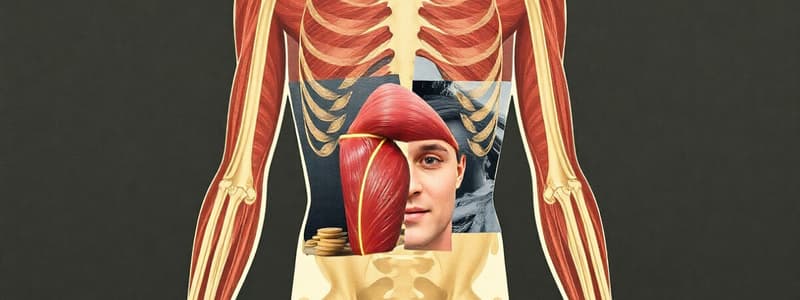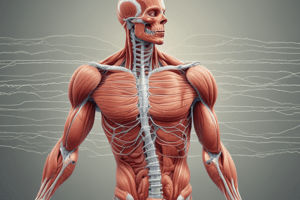Podcast
Questions and Answers
Which type of muscle is included in the muscular system?
Which type of muscle is included in the muscular system?
- Skeletal muscle (correct)
- All types of muscle
- Cardiac muscle
- Smooth muscle
What connective tissue surrounds the entire muscle?
What connective tissue surrounds the entire muscle?
- Endomysium
- Epimysium (correct)
- Aponeurosis
- Fascia
What is the primary function of skeletal muscle?
What is the primary function of skeletal muscle?
- Pumping blood
- Producing bodily movements (correct)
- Regulating body temperature
- Facilitating digestion
Which structure is NOT part of a muscle fiber?
Which structure is NOT part of a muscle fiber?
What are the small contractile units within myofibrils called?
What are the small contractile units within myofibrils called?
What is the role of T-tubules in a muscle fiber?
What is the role of T-tubules in a muscle fiber?
What type of connective tissue anchors muscle to the bone?
What type of connective tissue anchors muscle to the bone?
Which of the following is a characteristic of skeletal muscle fibers?
Which of the following is a characteristic of skeletal muscle fibers?
What is the primary role of sarcoplasmic reticulum in muscle fibers?
What is the primary role of sarcoplasmic reticulum in muscle fibers?
Which connective tissue wraps around individual muscle fibers?
Which connective tissue wraps around individual muscle fibers?
What are thin myofilaments primarily made of?
What are thin myofilaments primarily made of?
Which structure connects the thick filaments to the Z disk in a sarcomere?
Which structure connects the thick filaments to the Z disk in a sarcomere?
What does the A band in a sarcomere represent?
What does the A band in a sarcomere represent?
Which myofilament is involved in blocking binding sites on actin until muscle contraction is needed?
Which myofilament is involved in blocking binding sites on actin until muscle contraction is needed?
What is the function of the globular heads of thick myofilaments during muscle contraction?
What is the function of the globular heads of thick myofilaments during muscle contraction?
What contributes to the striated appearance of skeletal muscle?
What contributes to the striated appearance of skeletal muscle?
Where is the H zone located in a sarcomere?
Where is the H zone located in a sarcomere?
What encircles the myofibrils at the junction of the A and I bands?
What encircles the myofibrils at the junction of the A and I bands?
During muscle contraction, which component binds to calcium ions?
During muscle contraction, which component binds to calcium ions?
What function do antagonists serve in muscle movement?
What function do antagonists serve in muscle movement?
Which of the following statements best describes the role of synergists?
Which of the following statements best describes the role of synergists?
In a lever system involving the biceps brachii, what does the radius represent?
In a lever system involving the biceps brachii, what does the radius represent?
Which term describes muscle fibers that run at a 90-degree angle relative to a reference line?
Which term describes muscle fibers that run at a 90-degree angle relative to a reference line?
What term is used for muscles that decrease the angle between two bones?
What term is used for muscles that decrease the angle between two bones?
Which muscle is considered a synergist to the biceps brachii?
Which muscle is considered a synergist to the biceps brachii?
What distinguishes the triceps brachii in terms of its origins?
What distinguishes the triceps brachii in terms of its origins?
What is the primary action performed by abductors?
What is the primary action performed by abductors?
How is the gluteus maximus classified in terms of relative size?
How is the gluteus maximus classified in terms of relative size?
What type of lever system is created by the elbow joint with the radius and the contraction of the biceps?
What type of lever system is created by the elbow joint with the radius and the contraction of the biceps?
Flashcards are hidden until you start studying
Study Notes
The Muscular System
- The muscular system is comprised of skeletal muscle, not cardiac or smooth muscle.
- Skeletal muscle is voluntarily controlled, striated, attached to bone, responsible for body movement, and generates heat as a byproduct of contraction.
Connective Tissue
- Connective tissue associated with skeletal muscle includes fascia, tendons, and aponeuroses.
- Fascia encloses muscles and muscle groups.
- Epimysium surrounds the entire muscle.
- Perimysium wraps fascicles.
- Endomysium wraps individual muscle fibers.
- Tendons attach muscle to bone, and are extensions of fascia.
- The Achilles tendon is an example.
- Aponeuroses are sheet-like tendons anchoring muscle to connective tissue covering a bone.
- The galea aponeurotica between the frontal and occipital bones of the skull is an example.
Structure of a Fiber
- Muscle fibers are the unique term for muscle cells.
- Skeletal muscle fibers are long, cylindrical, and multinucleated.
- Each fiber consists of:
- Sarcolemma: Specialized muscle cell plasma membrane.
- T-tubules (transverse tubules): Continuations of the sarcolemma that extend deep into muscle fibers.
- Sarcoplasm: Cytoplasm of a muscle fiber.
- Sarcoplasmic reticulum: Smooth endoplasmic reticulum with terminal cisternae (expanded regions near T-tubules). Triads are T-tubules associated with two terminal cisternae.
Structure of Myofibrils
- Myofibrils are intracellular structures and organelles that form the muscle fiber.
- They are made up of bundles of myofilaments.
- Each myofibril is divided into contractile units called sarcomeres.
- Sarcomeres join end-to-end to form the myofibril.
Structure of Myofilaments
- Myofilaments are composed of two types:
- Thin myofilaments: Composed of actin, tropomyosin (a regulator that stabilizes actin and blocks binding sites until contraction), and troponin (a regulator that binds to calcium during contraction, also binds to actin as an inhibitor).
- Thick myofilaments: Composed of myosin, which has a rod-like tail and two globular heads. Globular heads bind to sites on actin facilitating muscle contraction. The globular head is also called a cross-bridge. Titin attaches the myosin to the Z band of the sarcomere.
Structure of a Sarcomere
- Sarcomeres are the contractile unit of muscle.
- Each sarcomere is an organized group of myofilaments.
- The dark and light bands within a sarcomere provide skeletal muscle with its striated appearance.
- Each sarcomere contains:
- A band: Spans the length of the thick filament. This band is dark and composed of actin and myosin.
- H zone: At the center of the A band. This is a light band composed of myosin.
- I band: This band is light and composed of actin, titin, and the Z disk.
- Z disks: Connect the sarcomeres. Thick filaments are connected to the Z disk by titin protein.
- M line: Where the myosin tails connect to one another at the center of the sarcomere.
- T tubules: Encircle the myofibrils at the junction of the A and I bands. There are two T tubules per sarcomere.
How Does Movement Occur?
- Muscles and bones produce movement by:
- Muscles pulling on bone when they contract: The origin of the muscle is on the stationary bone, and the insertion of the muscle is on the moving bone.
- Using group action:
- Agonists are the major muscle producing a movement.
- Antagonists act to oppose the agonist.
- Synergists act to help the agonist by either providing extra force or preventing undesirable effects of the agonist.
- Forming lever systems:
- Bone and muscle interact at a joint to accomplish movement.
- The lever is the bone.
- The joint is the fulcrum.
- The effort is the contraction of the agonist.
- The resistance opposes movement of the load.
Naming Skeletal Muscles
- Muscles are named based on:
- Location: Tibialis anterior vs. tibialis posterior.
- Relative size: Gluteus maximus, gluteus medius, gluteus minimus.
- Direction of muscle fibers:
- Rectus: Straight relative to a reference line.
- Transversus: At a 90° angle relative to a reference line.
- Oblique: Not at a 90° angle or straight relative to a reference line.
- Number of origins:
- Biceps brachii: 2 points on the scapula.
- Triceps brachii: 3 points on the scapula and humerus.
- Quadriceps femoris: 4 points on the ileum and femur.
- Shape of the muscle:
- Deltoid is triangular shaped.
- Trapezius is trapezoid shaped.
- The action they perform:
- Flexors: Decrease the angle between two bones.
- Extensors: Increase the angle between two bones.
- Abductors: Move the limb away from the midline.
- Adductors: Move the limb toward the midline.
Studying That Suits You
Use AI to generate personalized quizzes and flashcards to suit your learning preferences.




